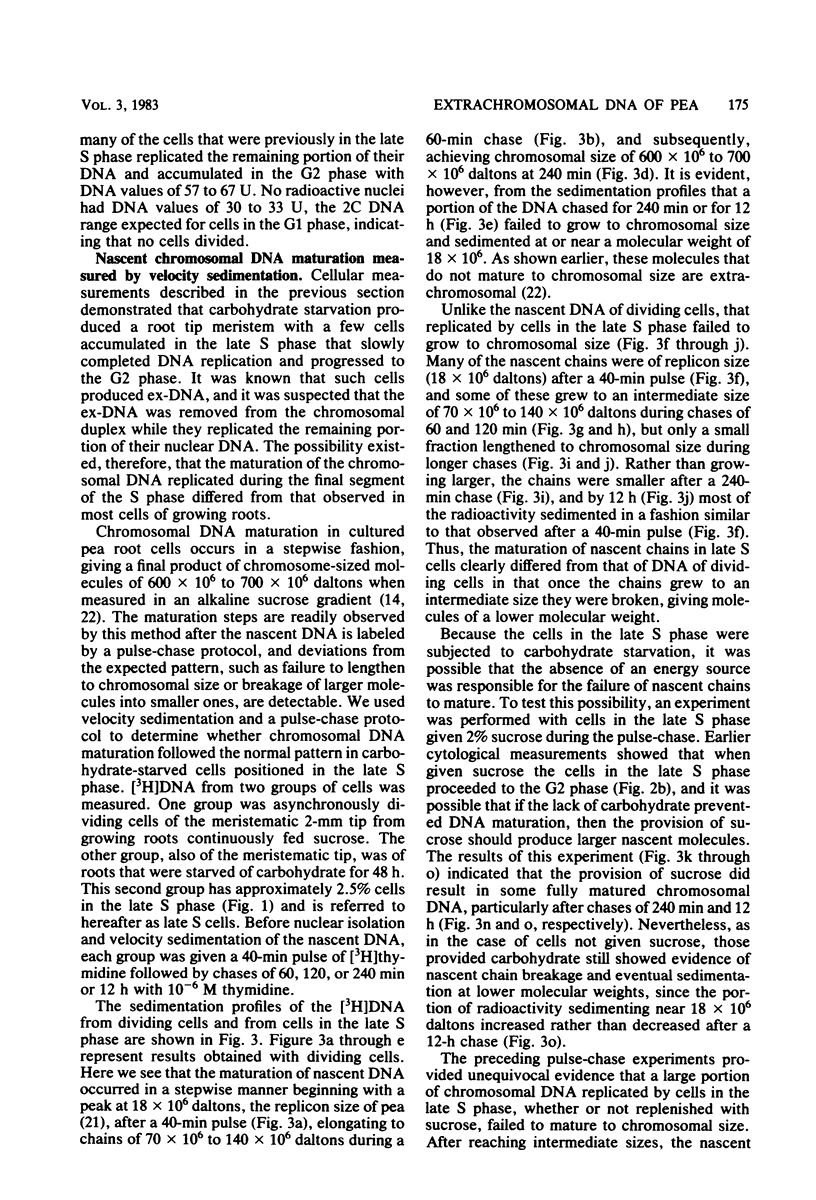Abstract
Experiments with cultured pea roots were conducted to determine (i) whether extrachromosomal DNA was produced by cells in the late S phase or in the G2 phase of the cell cycle, (ii) whether the maturation of nascent DNA replicated by these cells achieved chromosomal size, (iii) when extrachromosomal DNA was removed from the chromosomal duplex, and (iv) the replication of nascent chains by the extrachromosomal DNA after its release from the chromosomal duplex. Autoradiography and cytophotometry of cells of carbohydrate-starved root tips revealed that extrachromosomal DNA was produced by a small fraction of cells accumulated in the late S phase after they had replicated about 80% of their DNA. Velocity sedimentation of nascent chromosomal DNA in alkaline sucrose gradients indicated that the DNA of cells in the late S phase failed to achieve chromosomal size. After reaching sizes of 70 X 10(6) to 140 X 10(6) daltons, some of the nascent chromosomal molecules were broken, presumably releasing extrachromosomal DNA several hours later. Sedimentation of selectively extracted extrachromosomal DNA either from dividing cells or from those in the late S phase showed that it replicated two nascent chains, one of 3 X 10(6) daltons and another of 7 X 10(6) daltons. Larger molecules of extrachromosomal DNA were detectable after cells were labeled for 24 h. These two observations were compatible with the idea that the extrachromosomal DNA was first replicated as an integral part of the chromosomal duplex, was cut from the duplex, and then, once free of the chromosome, replicated two smaller chains of 3 X 10(6) and 7 X 10(6) daltons.
Full text
PDF









Selected References
These references are in PubMed. This may not be the complete list of references from this article.
- Braun R., Evans T. E. Replication of nuclear satellite and mitochondrial DNA in the mitotic cycle of Physarum. Biochim Biophys Acta. 1969 Jun 17;182(2):511–522. doi: 10.1016/0005-2787(69)90203-2. [DOI] [PubMed] [Google Scholar]
- Carrier W. L., Setlow R. B. Paper strip method for assaying gradient fractions containing radioactive macromolecules. Anal Biochem. 1971 Oct;43(2):427–432. doi: 10.1016/0003-2697(71)90272-7. [DOI] [PubMed] [Google Scholar]
- Evans L. S., Hof J van't Cell arrest in G2 in root meristems: a control factor from the cotyledons. Exp Cell Res. 1973 Dec;82(2):471–473. doi: 10.1016/0014-4827(73)90371-6. [DOI] [PubMed] [Google Scholar]
- Fox D. P. Some characteristics of the cold hydrolysis technique for staining plant tissues by the feulgen reaction. J Histochem Cytochem. 1969 Apr;17(4):266–272. doi: 10.1177/17.4.266. [DOI] [PubMed] [Google Scholar]
- Hirt B. Selective extraction of polyoma DNA from infected mouse cell cultures. J Mol Biol. 1967 Jun 14;26(2):365–369. doi: 10.1016/0022-2836(67)90307-5. [DOI] [PubMed] [Google Scholar]
- Kelly T. J., Jr, Lechner R. L. The structure of replicating adenovirus DNA molecules: characterization of DNA-protein complexes from infected cells. Cold Spring Harb Symp Quant Biol. 1979;43(Pt 2):721–728. doi: 10.1101/sqb.1979.043.01.080. [DOI] [PubMed] [Google Scholar]
- Kolodner R., Tewari K. K. Physicochemical characterization of mitochondrial DNA from pea leaves. Proc Natl Acad Sci U S A. 1972 Jul;69(7):1830–1834. doi: 10.1073/pnas.69.7.1830. [DOI] [PMC free article] [PubMed] [Google Scholar]
- Kolodner R., Tewari K. K. The molecular size and conformation of the chloroplast DNA from higher plants. Biochim Biophys Acta. 1975 Sep 1;402(3):372–390. doi: 10.1016/0005-2787(75)90273-7. [DOI] [PubMed] [Google Scholar]
- Meagher R. B., Shepherd R. J., Boyer H. W. The structure of cauliflower mosaic virus. I. A restriction endonuclease map of cauliflower mosaic virus DNA. Virology. 1977 Jul 15;80(2):362–375. doi: 10.1016/s0042-6822(77)80012-3. [DOI] [PubMed] [Google Scholar]
- Schvartzman J. B., Chenet B., Bjerknes C., Van't Hof J. Nascent replicons are synchronously joined at the end of S phase or during G2 phase in peas. Biochim Biophys Acta. 1981 Apr 27;653(2):185–192. doi: 10.1016/0005-2787(81)90154-4. [DOI] [PubMed] [Google Scholar]
- Singer I. I., Rhode S. L., 3rd Replication process of the parvovirus H-1. VII. Electron microscopy of replicative-form DNA synthesis. J Virol. 1977 Feb;21(2):713–723. doi: 10.1128/jvi.21.2.713-723.1977. [DOI] [PMC free article] [PubMed] [Google Scholar]
- Tattersall P., Ward D. C. Rolling hairpin model for replication of parvovirus and linear chromosomal DNA. Nature. 1976 Sep 9;263(5573):106–109. doi: 10.1038/263106a0. [DOI] [PubMed] [Google Scholar]
- Van't Hof J., Bjerknes C. A. Cells of pea (Pisum sativum) that differentiate from G2 phase have extrachromosomal DNA. Mol Cell Biol. 1982 Apr;2(4):339–345. doi: 10.1128/mcb.2.4.339. [DOI] [PMC free article] [PubMed] [Google Scholar]
- Vogt V. M., Braun R. The replication of ribosomal DNA in Physarum polycephalum. Eur J Biochem. 1977 Nov 1;80(2):557–566. doi: 10.1111/j.1432-1033.1977.tb11912.x. [DOI] [PubMed] [Google Scholar]
- Weinberg R. A. Integrated genomes of animal viruses. Annu Rev Biochem. 1980;49:197–226. doi: 10.1146/annurev.bi.49.070180.001213. [DOI] [PubMed] [Google Scholar]


